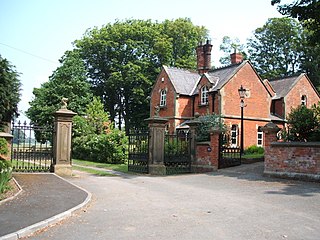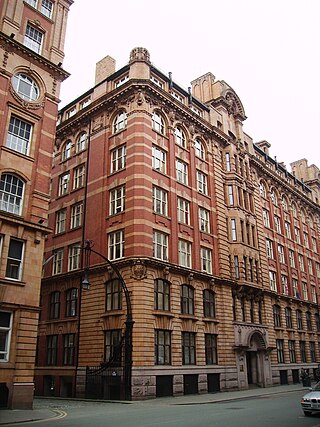
The John Rylands Research Institute and Library is a late-Victorian neo-Gothic building on Deansgate in Manchester, England. It is part of the University of Manchester. The library, which opened to the public in 1900, was founded by Enriqueta Augustina Rylands in memory of her husband, John Rylands. It became part of the university in 1972, and now houses the majority of the Special Collections of The University of Manchester Library, the third largest academic library in the United Kingdom.

Manchester Town Hall is a Victorian, Neo-gothic municipal building in Manchester, England. It is the ceremonial headquarters of Manchester City Council and houses a number of local government departments. The building faces Albert Square to the north and St Peter's Square to the south, with Manchester Cenotaph facing its southern entrance.

Singleton is a village and civil parish in Lancashire, England. It is situated on the coastal plain called the Fylde. It is located south-east of Poulton-le-Fylde, and at the 2001 census had a population of 877, increasing to 889 at the 2011 Census. The parish is sometimes referred to as two parts – Great Singleton is the larger part containing the village, and Little Singleton is a small area north of the village bordering the River Wyre.

The architecture of Manchester demonstrates a rich variety of architectural styles. The city is a product of the Industrial Revolution and is known as the first modern, industrial city. Manchester is noted for its warehouses, railway viaducts, cotton mills and canals – remnants of its past when the city produced and traded goods. Manchester has minimal Georgian or medieval architecture to speak of and consequently has a vast array of 19th and early 20th-century architecture styles; examples include Palazzo, Neo-Gothic, Venetian Gothic, Edwardian baroque, Art Nouveau, Art Deco and the Neo-Classical.

The Edgar Wood Centre is a former Church of Christ, Scientist building in Victoria Park, Manchester, England. The church was designed by Edgar Wood in 1903. Nikolaus Pevsner considered it "the only religious building in Lancashire that would be indispensable in a survey of twentieth century church design in all England". It is a Grade I listed building and has been on the Heritage at Risk Register published by Historic England.

Bridgewater House is a packing and shipping warehouse at 58–60 Whitworth Street, Manchester, England. It is recorded in the National Heritage List for England as a designated Grade II listed building.

The Memorial Hall in Albert Square, Manchester, England, was constructed in 1863–1866 by Thomas Worthington. It was built to commemorate the bicentennial anniversary of the 1662 Act of Uniformity. One of the best examples of Venetian Gothic revival in the city, the hall is a Grade II* listed building.

The former Manchester Law Library is a Grade II* listed building in the Venetian Gothic style at 14 Kennedy Street, Manchester. The building is notable as having housed the oldest provincial law library in England. Its architect, Thomas Hartas, is little known, and the former Law Library appears to be his only documented building. In 2015 the Manchester Incorporated Law Library Society sold the premises, and moved to new offices on Booth Street.

The Peacock Mausoleum is a Victorian Gothic memorial to Richard Peacock (1820–1889), engineer and Liberal MP for Manchester, and to his son, Joseph Peacock. It is situated in the cemetery of Brookfield Unitarian Church, Gorton, Manchester. The mausoleum was designed by the prolific Manchester architect Thomas Worthington. It was listed Grade II* on the National Heritage List for England on 3 October 1974.

Asia House at No. 82 Princess Street, Manchester, England, is an early 20th century packing and shipping warehouse built between 1906 and 1909 in an Edwardian Baroque style. It is a Grade II* listed building as at 3 October 1974. Nikolaus Pevsner's The Buildings of England describes the warehouse, and its companion, No. 86, Manchester House, as "quite splendid ... good examples of the warehouse type designed for multiple occupation by shipping merchants". It attributes its design to I.R.E. Birkett, architect of the Grade II listed companion building, Manchester House, which is similar in design. English Heritage attributes it to Harry S. Fairhurst. Asia House has an "exceptionally rich" entrance hall and stairwell, "lined with veined marble and green and cream faience, with designs of trees and Art Nouveau stained glass".

Lancaster House in Whitworth Street, Manchester, England, is a former packing and shipping warehouse built between 1905 and 1910 for Lloyd's Packing Warehouses Limited, which had, by merger, become the dominant commercial packing company in early 20th century Manchester. It is in the favoured Edwardian Baroque style and constructed with a steel frame clad with granite at the base and Accrington red brick and orange terracotta. The back of the building is plain red brick. It is a Grade II* listed building as of 3 October 1974.

India House in Whitworth Street, Manchester, England, is a packing and shipping warehouse built in 1906 for Lloyd's Packing Warehouses Limited, which had, by merger, become the dominant commercial packing company in early-20th century Manchester. It is in the favoured Edwardian Baroque style and is steel-framed, with cladding of buff terracotta and red brick with buff terracotta dressings. It is a Grade II* listed building as of 3 October 1974.

The Tootal, Broadhurst and Lee Building at No. 56 Oxford Street, in Manchester, England, is a late Victorian warehouse and office block built in a neo-Baroque style for Tootal Broadhurst Lee, a firm of textile manufacturers.

The Reform Club in Manchester, England, is a former gentlemen's club dating from the Victorian era. Built in 1870–1871 in the Venetian Gothic style, it was designed by Edward Salomons, in collaboration with an Irish architect, John Philpot Jones. The building is situated on the corner of King Street and Spring Gardens. Claire Hartwell, in her Manchester Pevsner City Guide considers the club Salomons' "best city-centre building" and it has a Grade II* heritage designation. The contract for construction was awarded to Mr Nield, a Manchester builder, and had a value of £20,000. The Reform was constructed as the club house for Manchester's Liberal Party, and was opened by Granville Leveson-Gower, 2nd Earl Granville, Liberal Foreign Secretary, on 19 October 1871.

The British Muslim Heritage Centre, formerly the GMB National College, College Road, Whalley Range, Manchester, is an early Gothic Revival building. The centre was designated a Grade II* listed building on 3 October 1974.

Manchester Town Hall Extension was built between 1934 and 1938 to provide additional accommodation for local government services. It was built between St Peter's Square and Lloyd Street in Manchester city centre, England. English Heritage designated it a grade II* listed building on 3 October 1974. Its eclectic style was designed to be a link between the ornate Gothic Revival Manchester Town Hall and the Classical architecture of the Central Library.

The Rylands Building is a Grade II listed building and former department store on Market Street in Manchester, England. It is situated in the Smithfield conservation area, which was known for its markets and textile warehouses, close to the Piccadilly area of Manchester city centre.
Manchester is a city in Northwest England. The M13 postcode area is to the south of the centre of the city and includes parts of the districts of Chorlton-on-Medlock and Longsight. The postcode area contains 38 listed buildings that are recorded in the National Heritage List for England. Of these, one is listed at Grade I, the highest of the three grades, seven are at Grade II*, the middle grade, and the others are at Grade II, the lowest grade. The area includes the main buildings of the University of Manchester, some of which are listed, as are some hospitals. The area is otherwise mainly residential, and the other listed buildings include houses, some of which have been converted for other uses, churches and chapels, public houses, former public baths, a museum, a milepost, railings, a statue, and a war memorial.






















